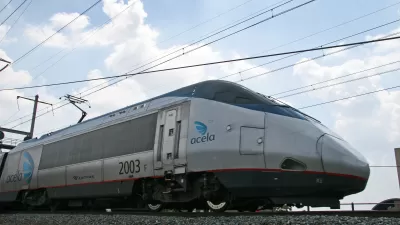Long lines at airport security and weather delays have contributed to Amtrak's commanding travel mode share between D.C. and NYC, and majority share between NYC and Boston, but the lead is threatened by the competition and aging infrastructure.
Ron Nixon describes how Amtrak travel in the Northeast, the nation's busiest corridor, took off after the introduction of Amtrak's high-speed Acela train in 2000. Prior to its introduction, the nation's train service had 37% of the travel between NY and D.C. and 20% between NY and Boston.
The mode share has jumped to 75% and 54% respectively, greatly boosted by the tightening of airport security after Sept. 11, 2001m which added long waits and inconvenience to air travel. Another highly valued amenity is the on-board wi-fi and ability to use cell phones.
"But success is taking a toll. Most days, trains in the Northeast are full. Several locomotives and railcars are 30 years old or more. Aging rails, bridges and tunnels hold down top speeds and limit expansion of the network.
Last month, Amtrak unveiled an ambitious $151 billion proposal to speed up trains and upgrade bridges and tracks."
Federal funding is lacking and competition is increasing.
"Amtrak faces a $6 billion backlog in maintenance projects nationwide. The transportation bill passed last month did not include money for rail projects. Transportation advocates like Jim Repass, president of the National Corridors Initiative, said this left Amtrak's budget subject to annual appropriation bills in Congress."
Amtrak's most formidable competition may not be the Delta Airlines and US Airways shuttle services that are facilitating the security check-in for their loyal customers but lower priced alternatives.
"BoltBus and MegaBus, two downtown, curbside services in the Northeast, have increased ridership since they began operating in 2008. The buses generally make the New York-to-Washington run in four and a half hours and offer free Wi-Fi. Tickets range from $1 to $40, far less than Amtrak or the airlines.
Research suggests that they are eating into Amtrak's market share. According to a study by the Chaddick Institute for Metropolitan Development at DePaul University, 34 percent of bus riders said they would have taken Amtrak if not for the bus."
FULL STORY: Frustrations of Air Travel Push Passengers to Amtrak

Alabama: Trump Terminates Settlements for Black Communities Harmed By Raw Sewage
Trump deemed the landmark civil rights agreement “illegal DEI and environmental justice policy.”

Study: Maui’s Plan to Convert Vacation Rentals to Long-Term Housing Could Cause Nearly $1 Billion Economic Loss
The plan would reduce visitor accommodation by 25% resulting in 1,900 jobs lost.

Why Should We Subsidize Public Transportation?
Many public transit agencies face financial stress due to rising costs, declining fare revenue, and declining subsidies. Transit advocates must provide a strong business case for increasing public transit funding.

Paris Bike Boom Leads to Steep Drop in Air Pollution
The French city’s air quality has improved dramatically in the past 20 years, coinciding with a growth in cycling.

Why Housing Costs More to Build in California Than in Texas
Hard costs like labor and materials combined with ‘soft’ costs such as permitting make building in the San Francisco Bay Area almost three times as costly as in Texas cities.

San Diego County Sees a Rise in Urban Coyotes
San Diego County experiences a rise in urban coyotes, as sightings become prevalent throughout its urban neighbourhoods and surrounding areas.
Urban Design for Planners 1: Software Tools
This six-course series explores essential urban design concepts using open source software and equips planners with the tools they need to participate fully in the urban design process.
Planning for Universal Design
Learn the tools for implementing Universal Design in planning regulations.
Smith Gee Studio
Alamo Area Metropolitan Planning Organization
City of Santa Clarita
Institute for Housing and Urban Development Studies (IHS)
City of Grandview
Harvard GSD Executive Education
Toledo-Lucas County Plan Commissions
Salt Lake City
NYU Wagner Graduate School of Public Service




























